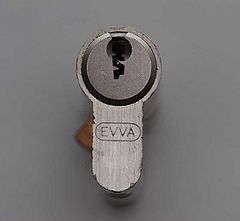EVVA DPS: Difference between revisions
TecknicalTom (talk | contribs) (adding pages to the "Lock models" category) |
mNo edit summary |
||
| Line 28: | Line 28: | ||
File:EVVA_DPS_key.jpg|A DPS key. | File:EVVA_DPS_key.jpg|A DPS key. | ||
File:EVVA_DPI_sidebar2.jpg|The key-profiling sidebar and moving element. | File:EVVA_DPI_sidebar2.jpg|The key-profiling sidebar and moving element. | ||
File:EVVA_DPI_sidebar2_plug.jpg|The key-profiling sidebar in the plug, correct key inserted. | |||
</gallery></div> | </gallery></div> | ||
| Line 51: | Line 52: | ||
== Gallery == | == Gallery == | ||
Add to me! | |||
<div align="center"><gallery> | <div align="center"><gallery> | ||
</gallery></div> | </gallery></div> | ||
Revision as of 17:18, 30 March 2011
EVVA DPS/EPS/DPX
| EVVA DPS/EPS/DPX | |
 | |
| Name | EVVA DPS/EPS/DPX |
|---|---|
| Manufacturer | EVVA |
| Lock Type | Cylinder |
| Lock Design | Pin-tumbler, Sidebar |
| Year(s) Produced | 1996-Present |
| Patent | US 5,797,287 |
The EVVA DPS (Double Profile System) is a pin-tumbler lock made by EVVA. The DPS uses five pin-tumblers and a single sidebar for key profiling, located at the 4 o'clock position. The EVVA EPS (Extra/Extended Profile System) model uses six pin tumblers instead.
The EVVA DPX (Double Profile eXtended) is a newer form of the DPS that provides two key-profiling sidebars in addition to the pin-tumbler components. Sidebars are located on each side of the plug, in the 4 and 8 o'clock positions. The DPX is also marketted as the Mottura PX in Europe.
Both the DPS and DPX have been superseded by the EVVA DPI to protect against key bumping attacks.
Principles of Operation
The DPS and DPX are traditional pin-tumblers with the addition of a key-profiling sidebar. In the case of the DPX, there are two sidebars that provide key-profiling.
In both cases the pin-tumblers function normally, and profile cuts on the side(s) of the key interface with the sidebar(s). The sidebar is active, and the center portion must be aligned properly or the third driver (top) pin will function as a trap pin when the plug is rotated.[1]
Disassembly instructions
- Remove the cam and C-clip.
- Insert the key and turn the plug 30-45 degrees in either direction.
- Slowly withdraw the plug from the cylinder.
Notes
- The plug may be difficult to remove at any 90 degree orientation because of the trap pin; 45 degree angles are recommended.
- The trap pin is beveled so it cannot fall out when removing the plug.
Vulnerabilities
The DPS/DPX may be vulnerable to one or more of the following:
Gallery
Add to me!


